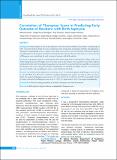Please use this identifier to cite or link to this item:
https://hdl.handle.net/20.500.14356/1274Full metadata record
| DC Field | Value | Language |
|---|---|---|
| dc.contributor.author | Shrestha, Sabina | - |
| dc.contributor.author | Dhungana, Sangita Puree | - |
| dc.contributor.author | Shrestha, Sujit | - |
| dc.contributor.author | Shrestha, Gentle Sunder | - |
| dc.date.accessioned | 2023-05-04T07:11:26Z | - |
| dc.date.available | 2023-05-04T07:11:26Z | - |
| dc.date.issued | 2020 | - |
| dc.identifier.citation | ShresthaS., DhunganaS. P., ShresthaS., & ShresthaG. S. (2020). Correlation of Thompson Score in Predicting Early Outcome of Newborn with Birth Asphyxia. Journal of Nepal Health Research Council, 18(3), 406-410. https://doi.org/10.33314/jnhrc.v18i3.2746 | en_US |
| dc.identifier.issn | Print ISSN: 1727-5482; Online ISSN: 1999-6217 | - |
| dc.identifier.uri | http://103.69.126.140:8080/handle/20.500.14356/1274 | - |
| dc.description | Original Article | en_US |
| dc.description.abstract | Abstract Background: Birth asphyxia is one of the important causes of neonatal morbidity and mortality, accounting up to 30% of neonatal death in Nepal. It is also an important cause of long term neurological disability and impairment. Thompson encephalopathy score is a clinical score which can be used to assess the newborn with hypoxic ischemic encephalopathy for the prognosis and their neurodevelopmental outcome. The aim of the study was to assess the role of Thompson score in predicting the early outcome of neonates with birth asphyxia. Methods: A prospective study was conducted from May 2019 to April 2020 in Nepal Medical College. All the term babies during the period with Apgar score of less than seven at five minutes were considered to have birth asphyxia and included in the study. Neurological examination was done on first, second and third day using HIE score proposed by Thompson and severity of hypoxic ischemic encephalopathy was classified accordingly. Outcome was measured as normal, morbidity with encephalopathy, seizure, organ dysfunction and death. Results: Out of 391 newborn admitted to neonatal unit, 84 (21.4%) had birth asphyxia. Mild Thompson score on day 1,2,3 were 49(58.3%), 49 (58.3%), 51(60.7%); moderate Thompson score on day 1,2,3 were 21 (25%), 21 (25%), 18(21.4%) and severe Thompson score on day 1, 2, 3 were 14 (16.7%), 14 (16.7%), 15(17.9%) respectively. Out of 14 babies who had severe Thompson score on day 1, 11(91.7%) expired and 3 (16.7%) developed encephalopathy. Conclusions: There was strong correlation of severity of Thompson score with the outcome. Keywords: Birth asphyxia; hypoxic ischemic encephalopathy; thompson score | en_US |
| dc.language.iso | en | en_US |
| dc.publisher | Nepal Health Research Council | en_US |
| dc.relation.ispartofseries | Jul-Sep 2020; | - |
| dc.subject | Birth asphyxia | en_US |
| dc.subject | Hypoxic ischemic encephalopathy | en_US |
| dc.subject | Thompson score | en_US |
| dc.title | Correlation of Thompson Score in Predicting Early Outcome of Newborn with Birth Asphyxia | en_US |
| dc.type | Journal Article | en_US |
| local.journal.category | Original Article | - |
| Appears in Collections: | Vol. 18 No. 3 (2020): Vol. 18 No. 3 Issue 48 Jul-Sep 2020 | |
Files in This Item:
| File | Description | Size | Format | |
|---|---|---|---|---|
| 2746-Manuscript-18832-1-10-20201115.pdf | Fulltext Article. | 215.41 kB | Adobe PDF |  View/Open |
Items in DSpace are protected by copyright, with all rights reserved, unless otherwise indicated.
